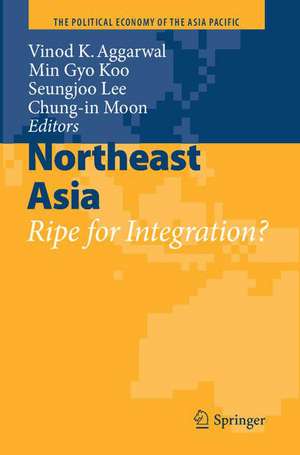Northeast Asia: Ripe for Integration?: The Political Economy of the Asia Pacific
Editat de Vinod K. Aggarwal, Min Gyo Koo, Seungjoo Lee, Chung-in Moonen Limba Engleză Paperback – 17 apr 2009
| Toate formatele și edițiile | Preț | Express |
|---|---|---|
| Paperback (2) | 389.31 lei 6-8 săpt. | |
| Springer – 17 apr 2009 | 389.31 lei 6-8 săpt. | |
| Springer Berlin, Heidelberg – 21 noi 2014 | 559.99 lei 38-44 zile | |
| Hardback (1) | 645.14 lei 6-8 săpt. | |
| Springer Berlin, Heidelberg – 6 oct 2008 | 645.14 lei 6-8 săpt. |
Din seria The Political Economy of the Asia Pacific
- 15%
 Preț: 649.06 lei
Preț: 649.06 lei - 18%
 Preț: 1224.36 lei
Preț: 1224.36 lei - 20%
 Preț: 550.14 lei
Preț: 550.14 lei - 15%
 Preț: 639.25 lei
Preț: 639.25 lei - 15%
 Preț: 639.25 lei
Preț: 639.25 lei - 18%
 Preț: 1222.94 lei
Preț: 1222.94 lei - 20%
 Preț: 566.75 lei
Preț: 566.75 lei -
 Preț: 385.84 lei
Preț: 385.84 lei - 23%
 Preț: 773.65 lei
Preț: 773.65 lei -
 Preț: 382.18 lei
Preț: 382.18 lei -
 Preț: 262.09 lei
Preț: 262.09 lei - 15%
 Preț: 652.17 lei
Preț: 652.17 lei - 15%
 Preț: 646.30 lei
Preț: 646.30 lei - 24%
 Preț: 631.50 lei
Preț: 631.50 lei - 18%
 Preț: 720.53 lei
Preț: 720.53 lei -
 Preț: 197.79 lei
Preț: 197.79 lei - 15%
 Preț: 637.13 lei
Preț: 637.13 lei -
 Preț: 369.48 lei
Preț: 369.48 lei
Preț: 389.31 lei
Nou
Puncte Express: 584
Preț estimativ în valută:
74.50€ • 76.30$ • 61.97£
74.50€ • 76.30$ • 61.97£
Carte tipărită la comandă
Livrare economică 18 martie-01 aprilie
Preluare comenzi: 021 569.72.76
Specificații
ISBN-13: 9781441903679
ISBN-10: 1441903674
Pagini: 288
Ilustrații: XVI, 268 p.
Dimensiuni: 155 x 235 x 20 mm
Greutate: 0.45 kg
Ediția:2009
Editura: Springer
Colecția Springer
Seria The Political Economy of the Asia Pacific
Locul publicării:New York, NY, United States
ISBN-10: 1441903674
Pagini: 288
Ilustrații: XVI, 268 p.
Dimensiuni: 155 x 235 x 20 mm
Greutate: 0.45 kg
Ediția:2009
Editura: Springer
Colecția Springer
Seria The Political Economy of the Asia Pacific
Locul publicării:New York, NY, United States
Public țintă
ResearchTextul de pe ultima copertă
Can regional mechanisms better institutionalize the increasing complexity of economic and security ties among the countries in Northeast Asia? As the international state system undergoes dramatic changes in both security and economic relations in the wake of the end of the Cold War, the Asian financial crisis, and the attack of 9/11, this question is now at the forefront of the minds of both academics and policymakers. Still, little research has been done to integrate the analysis of security and economic analysis of changes in the region within a broader context that will give us theoretically-informed policy insights. Against this backdrop, this book investigates the origins and evolution of Northeast Asia's new institutional architecture in trade, finance, and security from both a theoretical and empirical perspective.
Northeast Asia is a region of great strategic significance in the international system. This book brings together an impressive array of scholars to analyze the prospects for deeper regional integration in Northeast Asia. Insightful and theoretically framed, this is crucial reading for anyone interested in understanding the dynamics of economic, political, and security relations in one of the world's most important and fascinating regions.
Christopher M. Dent, University of Leeds
The editors have assembled a distinguished group of country and regional specialists in this innovative project on the shifting institutional dynamics of Northeast Asia. The systematic application of a framework that facilitates comparison of international strategic and economic interests, domestic power dynamics, and elite beliefs across the major players in the region is one of the book's major contributions. The chapters, combining empirical richness and theoretical sophistication, give particular attention to the interaction between regional and global institutions on the one hand and country characteristics on the other. With many commentators arguing that a new institutional framework is needed to address security issues in Northeast Asia, the publication of Northeast Asia: Ripe for Integration is particularly timely.
John Ravenhill, Australian National University
Northeast Asia is a region of great strategic significance in the international system. This book brings together an impressive array of scholars to analyze the prospects for deeper regional integration in Northeast Asia. Insightful and theoretically framed, this is crucial reading for anyone interested in understanding the dynamics of economic, political, and security relations in one of the world's most important and fascinating regions.
Christopher M. Dent, University of Leeds
The editors have assembled a distinguished group of country and regional specialists in this innovative project on the shifting institutional dynamics of Northeast Asia. The systematic application of a framework that facilitates comparison of international strategic and economic interests, domestic power dynamics, and elite beliefs across the major players in the region is one of the book's major contributions. The chapters, combining empirical richness and theoretical sophistication, give particular attention to the interaction between regional and global institutions on the one hand and country characteristics on the other. With many commentators arguing that a new institutional framework is needed to address security issues in Northeast Asia, the publication of Northeast Asia: Ripe for Integration is particularly timely.
John Ravenhill, Australian National University
Cuprins
Economic and Security Institution Building in Northeast Asia: An Analytical Overview.- South Korea's Regional Economic Cooperation Policy: The Evolution of an Adaptive Strategy.- Rhetoric or Vision? Chinese Responses to U.S. Unilateralism.- Under Pressure: Japan's Institutional Response to Regional Uncertainty.- North Korea's Strategy for Regime Survival and East Asian Regionalism.- Impassive to Imperial? Russia in Northeast Asia from Yeltsin to Putin.- Security in Northeast Asia: Time for New Architecture?.- The Future of Northeast Asia's Institutional Architecture.
Caracteristici
Includes supplementary material: sn.pub/extras






